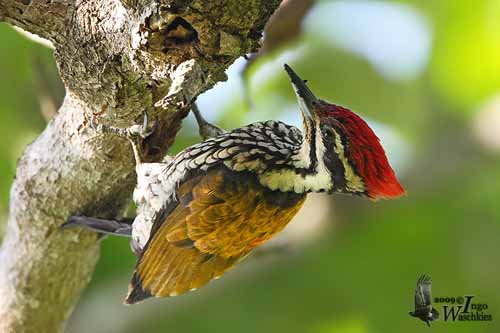
Fr: Pic à dos rouge
All: Feuerrückenspecht
Esp: Pito Culirrojo
Ital: Picchio dorsodorato di Giava
Nd: Javaanse Goudrugspecht
Sd: Guldryggad sultanspett
Photographer:
Ingo Waschkies
My bird pictures on Pbase
Texte de Nicole Bouglouan
Sources:
HANDBOOK OF THE BIRDS OF THE WORLD Vol. 7 by Josep del Hoyo-Andrew Elliott-Jordi Sargatal – Lynx Edicions – ISBN: 8487334377
LES OISEAUX DE THAILANDE par Roland Eve et Anne-Marie Guigue - Times Editions - ISBN: 9812042008
BirdLife International (BirdLife International)
Wikipedia, the free encyclopaedia
Common Flameback or Goldenback
Dinopium javanense
Piciforme Order – Picidae Family
BIOMETRICS:
Length: 28-30 cm
Weight: 67-90 g
DESCRIPTION:
The Common Flameback is a large woodpecker. Its contrasted bright plumage makes this bird a ray of sunlight among branches and foliage.
Adult male has bright coloured plumage. On the upperparts, hind neck and upper mantel are black. The rest of upperparts are olive, strongly washed golden. The feathers are edged yellow and we can see sometimes orange or red tinge on the back. The lower back and the rump are bright red.
The blackish-brown uppertail-coverts may be tinged olive and the tail is black. The flight feathers are blackish-brown with white spots on inner webs. Secondary and tertial flight feathers show olive-yellow outer webs.

On the underparts, the background is white, with edged and tipped-black feathers giving conspicuous scaled effect, with heavier markings on the breast. The lower underparts are rather barred than scaled.
The underwing is brown with white spots. The undertail feathers are blackish-brown.
On the head, crown and crest are red, whereas forehead and upper lores are brownish-red. The crown is finely edged black. The head sides are black and white, with a black stripe from the eye to the nape, and a narrow black moustachial line extending down to the upper breast.
A white supercilium extends from above the eye to the nape side, and a broad white stripe crosses the cheeks from the lores and extends down to neck and breast sides.
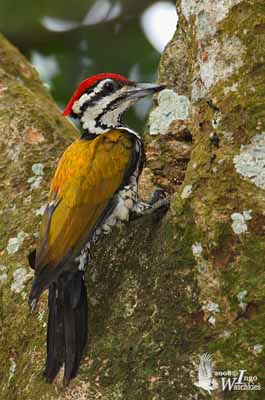
Chin and throat are creamy-white, crossed by a line of small black spots from the bill base to the lower throat.
The bill is blackish with paler base, relatively short and curved on culmen. The eyes are reddish-brown or brown, with narrow black eye-ring. The legs and the three toes are grey or brown, often tinged greenish.
The female is very similar but she is duller than male. On the head, crown and crest are black, finely streaked white.
The juvenile resembles adults. It has blackish-brown breast with white spots and the lower underparts are darker. The eyes are greyer.
The young male has black forehead and crown and red crest, whereas the young female has pale streaks on the crown.
We find six subspecies which slightly differ from nominate race in size, and more or less bright colours and pattern.
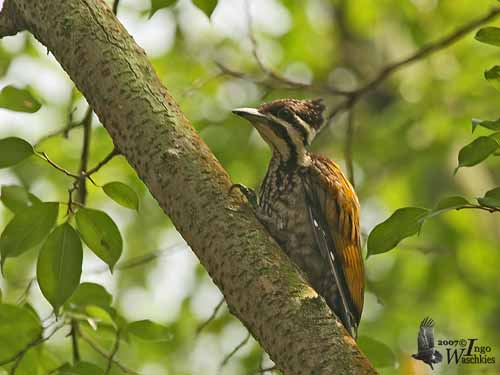
VOICE: SOUNDS BY XENO-CANTO
The Common Flameback utters variable series of notes. In flight, it gives several “kwop-owp-owp-owp”. When perched, it utters a single “kow” of two “kow-kow”. We can also hear rattle, harsh “churrrr” and fast “ka-di-di-di-di”.
It also performs rapid drums.
HABITAT:
The Common Flameback frequents moist open forest and deciduous woodlands, mangroves and scrub. At higher elevation, it frequents pine forests.
It is often seen in cultivated areas, parks and gardens, and usually in lowlands, but according to the range, also up to 1000, 1500 and 1700 metres of elevation.
RANGE:
The Common Flameback occurs in India, Bangladesh, C and E Myanmar, SC China, N Vietnam, Thailand, Cochinchina, W and C Philippines, Java, Sumatra, Borneo and Bali.
BEHAVIOUR:
The Common Flameback feeds mainly on invertebrates, various insects and larvae. It forages at all levels in woodlands and although it prefers the lower parts of the trees, it also forages near the treetop or at mid level.
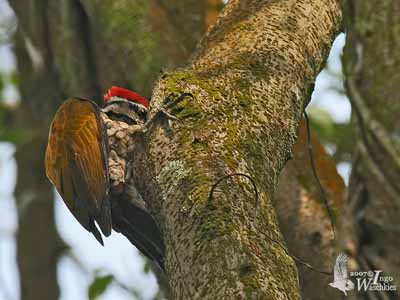
It gleans and probes in bark crevices and pecks after removing pieces of bark. It often makes short pauses while climbing quickly. It also hawks insects.
These woodpeckers are often seen in pairs and sometimes with other Picidae species. They also consume plant matter such as berries, fruits and seeds.
During the courtship displays, both mates chase each other throughout the trees. The displays involve crest-raising, bowing and head-swinging. The male performs courtship feeding to the female. They nest in holes in trees.
This species is resident in its range.
FLIGHT:
The Common Flameback performs undulating, fast flight.
REPRODUCTION:
The breeding season varies according to the range.
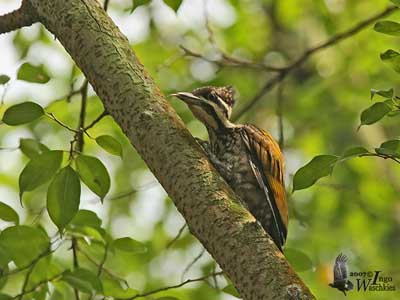
The Common Flameback, as other woodpeckers, excavates a hole in tree trunk, stumps or large branches for nesting. The hole is between 1, 50 and 10 metres above the ground, but usually below 5 metres. The nest is often excavated in fruit-tree or coconut-palm, and in open area.
The female lays 2-3 eggs.
The nesting behaviour of this species is currently unknown.
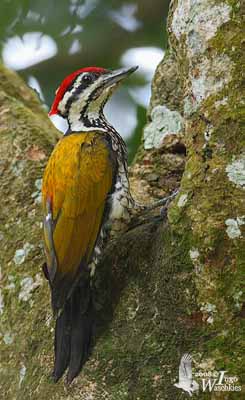
DIET:
The Common Flameback feeds on invertebrates such as small scorpions, cockroaches, insects and larvae and ants. It also consumes berries, fruits and seeds.
PROTECTION / THREATS / STATUS:
The Common Flameback is locally common according to the range.
This species could be threatened by habitat loss, but its preference for open woodlands allows it to find suitable nest-sites and feeding areas.
The Common Flameback’s populations are not currently threatened, and evaluated as least Concern.